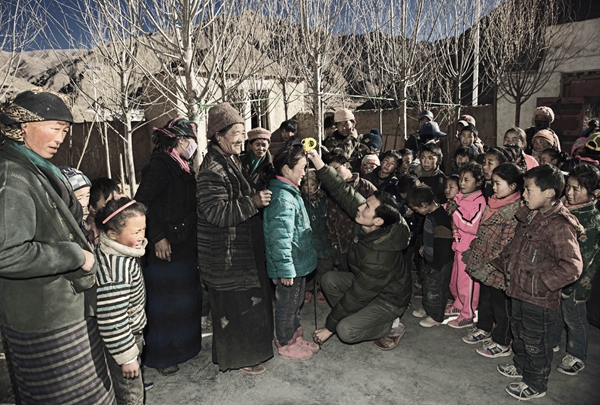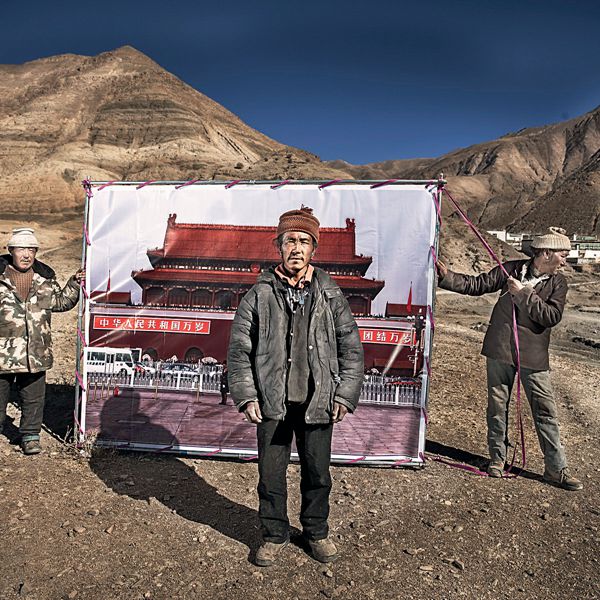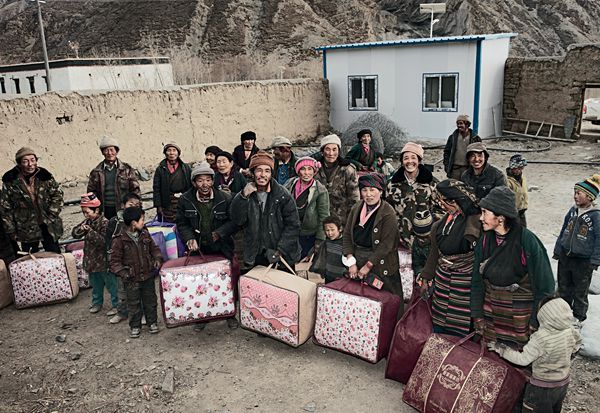By staff reporter ZHANG XIAO
By staff reporter ZHANG XIAO
JUST five years ago, residents of Bading Village, Chagjug Town, Sagya County, Xigaze City in Tibet Autonomous Region (TAR) had neither running water nor electricity. Owing to poor transport and telecommunications they lived in almost total social isolation. However, great changes have occurred in that short space of time. Solar street lighting, a local area network (LAN), and the construction of a cement road have given the village a brand new look. All these changes are thanks to the efforts of a work team sent by the TAR Department of Science and Technology.
Tailor-made Plans to Benefit Local Residents
Bading Village is one of three sites in Chagjug Town to which the TAR Science and Technology Department sent a team to help the local poverty alleviation effort. Compared with the two other villages, Bading is more remote and, with no electricity, conditions there were even worse.

Losang, a stationed cadre, measures the children so he can help buy them new winter clothes.
Extremely ragged infrastructure was the biggest challenge facing the team of cadres stationed in the village. Locals eked out a living through farming and herding, and with no running water, electricity, roads or telecommunications, life was primitive. Upon arrival in Bading, the team immediately set about visiting local households to determine their needs. They could then make targeted plans to maintain local stability, promote economic development, and solve various problems. They decided to focus their efforts on improving local infrastructure, helping locals increase their incomes, and transforming the economic development mode. The team accordingly sketched out a three-year and five-year plan for the village.
With the support of local government at both county and township levels, the work team stationed in Bading used all available channels to supply the village with electricity and enable locals to communicate with each other and the outside world. They built a road, an irrigation reservoir, and a potable water supply system. They also launched training schemes for local government officers to enable them to better serve local people, and helped to establish rural cooperatives.
The Tibet Department of Science and Technology endorsed the establishment of four vegetable greenhouses and a 3.3-plus hectare planting area for alfalfa. It also set up an agricultural processing plant, a chicken farm with egg incubators, a potable water supply, a well, and a village clinic, according to Chimed Tsering, leader of the village-stationed cadre team and secretary of the Bading Village Committee of the Communist Party of China (CPC). All the newly established facilities have met the basic needs of local people and substantially improved their environment and living conditions.
“In the past, local people ate few vegetables other than potatoes and radishes. Since the construction of greenhouses, they have a choice of various leafy green vegetables. The agricultural processing factory produces flour, oil, and Tsampa, the Tibetan staple food, so villagers don’t need to go elsewhere to buy these foodstuffs at high prices,” Chimed Tsering said.

Many people wish to take a picture in front of Tian’anmen in Beijing. One villager, Padma, poses in front of a picture of Tian’anmen at the village before he can really go to the capital.
The village-stationed cadres have gone to great lengths to promote science and technology. They selected two villagers for training in scientific knowledge and technologies. They, in turn, instruct other villagers each year in crop growing and livestock farming. Each local technician is equipped with a mobile data terminal that gives access to pictures, texts and Tibetan language videos. This makes it much easier for technicians to pass on relevant agricultural technologies among local farmers. To further enhance the spread of information, a wireless LAN covering the whole village has been established.
“The team has wrought huge changes in Bading Village,” secretary of the CPC Chagjug Town Committee, Jiang Ming-lei, said. “Cadres have made every effort to advance local economic development and improve local infrastructure. Funds have been invested and yielded good results,” Jiang added.
The standard of education in Bading Village has in the past been consistently low. Social progress and the development of China’s education system, however, have highlighted the importance of schooling. Bading Village has a total of 120 students, seven of whom are college undergraduates. To encourage more poor students to stay in education, village-stationed cadres have worked with the Tibet Institute of Scientific and Technological Information to solicit donations and set up scholarships for students from impoverished families.
Cadres have contacted various charity organizations and people willing to help, and received from them donations of brand new winter clothes worth around RMB 170,000, as well as 1,800 items of used clothing and various stationery items. The team also allocates RMB 10,000 every year for buying quilts and warm clothes for poor people, demobilized soldiers, and senior citizens.
Shaking off Poverty
Over the past five years, the hard work of village-stationed cadres has transformed Bading Village. There are now only 20 poor households in the village – around 40 percent of the total 52 – which is a considerably reduced proportion. Large scale infrastructure construction has created many job opportunities for locals, enabling them to stay with their families and work in the village rather than living and working elsewhere. In 2015, Bading Village generated revenues exceeding RMB 200,000. Improvements to the local infrastructure and living environment have thus brought local villagers higher incomes and a better life.

Quilts are allocated to poor people and the elderly.
“We are very happy to see that our efforts have paid off,” Chimed Tsering said. “We hope to build Bading into a moderately prosperous village by 2020,” he added.
The recently launched 13th Five-Year Plan (2016-2020) represents the “home straight” to the goal of building a moderately wealthy society. It’s the first Five-Year Plan after China’s economy entered the “new normal” stage. At a national conference on poverty relief held last year, Chinese President Xi Jinping pledged resolute measures to combat poverty in China, urging joint efforts at all levels. Tibet, with its large contiguous poverty-stricken area, faces an arduous task.
Suggestions on Tibet’s 13th Five-Year Plan on National Economic and Social Development was adopted on December 13, 2015, at the eighth plenary session of the 8th CPC Tibet Autonomous Regional Committee. It set the goal of helping Tibet’s remaining 690,000 poor people shake off poverty by 2020. The poverty rate, showing the percentage of the population below the official poverty line, will be curbed to below 5 percent, and the disposable income of poor people increased by at least 16 percent annually.
Relevant departments at different levels in Tibet have made poverty alleviation a top priority in their efforts to achieve the goal of “building a moderately prosperous society” by 2020. Joint efforts will be made to take targeted approaches to alleviate poverty.
At a meeting between the TAR government and the State Council Leading Group Office of Poverty Alleviation and Development held on August 13, 2016, Losang Jamcan, deputy secretary of the CPC Tibet regional committee, chairman of Tibet Autonomous Region, and vice executive director of the Tibet Regional Leading Group of Poverty Alleviation, said: “We will explore targeted measures that are in line with local conditions in Tibet to alleviate poverty, so as to achieve the goal of helping all poor people shake off poverty and of building a moderately prosperous society by 2020.”